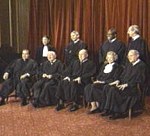|
|
|
|
|
|
|
News & Views item - April 2007 |
![]() U.S. Supreme Court Rules Four Motor Vehicle Produced Greenhouse Gases are
Pollutants. (April 3, 2007)
U.S. Supreme Court Rules Four Motor Vehicle Produced Greenhouse Gases are
Pollutants. (April 3, 2007)
 The
decision was close, 5 to 4, but the
United States Supreme Court yesterday ruled that carbon dioxide,
methane, nitrous oxide, and hydrofluorocarbons are pollutants and the
Environmental Protection Agency (EPA) under the Clean Air Act has the authority
to regulate heat-trapping gases in motor vehicle emissions.
The
decision was close, 5 to 4, but the
United States Supreme Court yesterday ruled that carbon dioxide,
methane, nitrous oxide, and hydrofluorocarbons are pollutants and the
Environmental Protection Agency (EPA) under the Clean Air Act has the authority
to regulate heat-trapping gases in motor vehicle emissions.
According to The New York Times Linda Greenhouse the, "decision was a strong rebuke to the Bush administration, which has maintained that it does not have the right to regulate carbon dioxide and other heat-trapping gases under the Clean Air Act, and that even if it did, it would not use the authority. The ruling does not force the environmental agency to regulate auto emissions, but it would almost certainly face further legal action if it failed to do so."
The five assenting justices are Justice John Paul Stevens, Anthony M. Kennedy, David H. Souter, Ruth Bader Ginsburg and Stephen G. Breyer. In their opinion they said that by providing nothing more than a “laundry list of reasons not to regulate,” the environmental agency had defied the Clean Air Act’s “clear statutory command.” Justice Stevens writing for the majority said a refusal to regulate could be based only on science and “reasoned justification”, and the Administration's reasons for inaction had "nothing to do with whether greenhouse gas emissions contribute to climate change and do not amount to a reasoned justification for declining to form a scientific judgment."
Citing recent scientific reports including the United Nations' Intergovernmental Panel on Climate Change and a 2001 National Academies' National Research Council (NRC) report on climate change the court argued "greenhouse gases are accumulating in Earth's atmosphere as a result of human activities, causing surface air temperatures and subsurface ocean temperatures to rise." And EPA's refusal to regulate auto emissions contributes to the possibility of coastal flooding and other damage to Massachusetts and the other plaintiff states.
The majority opinion, made the point that in fact the EPA,“does not dispute the existence of a causal connection between man-made gas emissions and global warming [and] judged by any standard, U.S. motor-vehicle emissions make a meaningful contribution to greenhouse gas concentrations.”
Eli Kintisch in ScienceNow reports, "In the first of two dissents, Chief Justice John Roberts and three colleagues said that Massachusetts's stated injury--which is needed to fulfill a lawsuit requirement called standing--was too tenuously linked to emissions, making the suit invalid. A second dissent by the same group, written by Antonin Scalia, attacked the merits of the argument, namely that C02, which does not directly impact humans, could be defined as a pollutant. 'It follows that everything airborne, from Frisbees to flatulence, qualifies as an "air pollutant,"' the dissent read."
The decision overturned a 2005 ruling by the Washington, D.C. federal
appeals court.
A second decision brought down by the Supreme Court on Monday also left environmentalists elated.
In a 9-0 decision it adopted a broad interpretation of the EPA's authority over factories and power plants that add capacity or make renovations that increase emissions of air pollutants thereby reopened a federal enforcement effort against the Duke Energy Corporation under the Clean Air Act’s “new source review” provision.